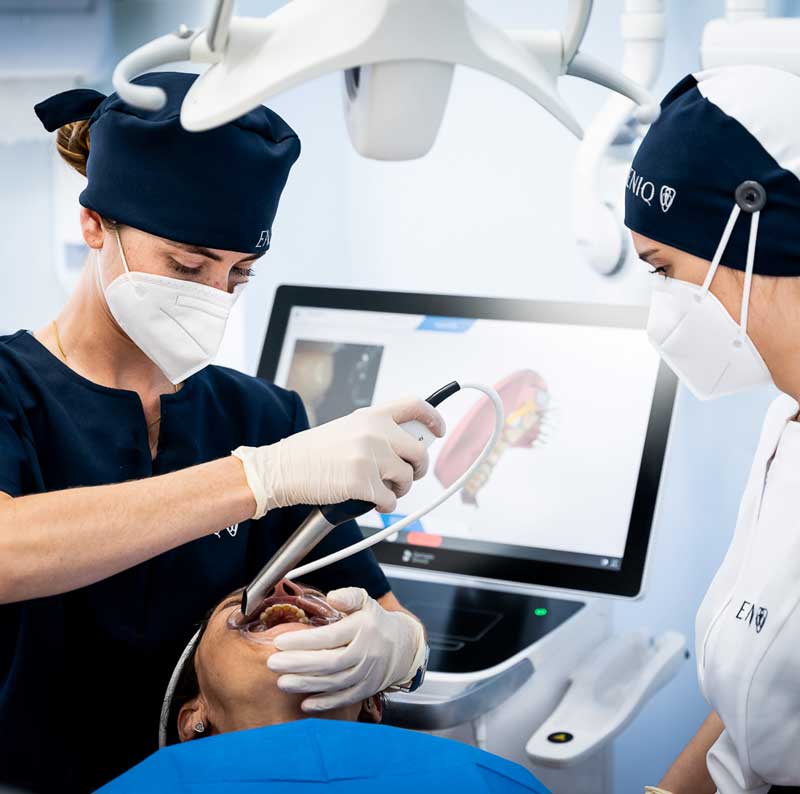

Pain-Free Dentistry
Advanced technologies for a pain-free dental experience.
What is Pain-Free Dentistry?
Pain-Free Dentistry is an approach in dental practice that aims to minimize or eliminate pain and discomfort during dental procedures. Advances in technology, techniques, and medications have allowed dentists to offer more comfortable and less painful treatments for patients.
There are several techniques and strategies used in Pain-Free Dentistry, including:
- Local Anesthesia: It is the most common method to numb a specific area of the mouth before performing a dental procedure. Local anesthesia is administered through an injection to numb the nerves and prevent pain.
- Conscious Sedation: In some cases, conscious sedation can be used to help patients relax during dental treatments. This is achieved by administering medications that induce a state of relaxation and drowsiness, allowing the patient to remain conscious and responsive to stimuli.
- Advanced Technology: Technology has advanced in the field of dentistry, enabling less invasive and more precise procedures. For example, the use of dental lasers can reduce pain and discomfort during certain treatments, and digital radiography provides quick and detailed images with less radiation exposure.
- Communication and Empathy: Dentists practicing Pain-Free Dentistry focus on establishing open and empathetic communication with their patients. They listen to their concerns, explain procedures step by step, and provide emotional support to reduce anxiety and fear associated with dental visits.
It's important to note that while Pain-Free Dentistry aims to minimize pain and discomfort, some dental procedures may still involve some discomfort or sensitivity. However, advances in this field have significantly improved the patient experience and made dental treatments much more tolerable. If you have concerns about pain during a dental procedure, I would recommend discussing available options and how they can be tailored to your needs with your dentist.
What Methods Are Available for Performing Pain-Free Dental Procedures?
There are various procedures and techniques used in Pain-Free Dentistry to minimize or eliminate the sensation of pain during dental treatments. Some of them include:
- Local Anesthesia: Topical anesthetics and digital anesthesia can be used to allow dental procedures to be performed without feeling pain.
- Conscious Sedation: Conscious sedation is used to help patients relax during dental treatments. Medication is administered orally or through inhalation to induce a feeling of relaxation and tranquility. Although the patient remains conscious and able to respond to stimuli, they often experience reduced anxiety and pain sensitivity.
- Intravenous (IV) Sedation: Intravenous sedation is a deeper level of sedation administered through a vein. An anesthesiologist or a dentist with training in intravenous sedation supervises and controls the medication dosage. This form of sedation allows for a deeper state of relaxation and may be used in more extensive or complex procedures.
- Use of Advanced Technology: Technology has allowed for the development of devices and techniques that reduce pain and discomfort during dental procedures. For example, the use of dental lasers can reduce the need for local anesthesia in certain cases and decrease discomfort during treatment. Additionally, digital imaging and 3D radiographs allow for more precise procedure planning, which can help minimize time and discomfort during treatment.
- Communication and Distraction Techniques: Open communication between the dentist and the patient, as well as the use of distraction techniques, can help reduce anxiety and fear, subsequently reducing the perception of pain. The dentist can explain each step of the procedure to the patient, use relaxation techniques such as deep breathing, or provide music or videos to divert the patient's attention.
It's important to emphasize that each case is unique, and the methods for achieving pain-free dentistry may vary depending on the patient's needs and preferences, as well as the nature of the dental procedure. If you are interested in receiving pain-free dental treatment, I recommend discussing available options with your dentist to find the best solution for you.
Benefits
What are the benefits of getting a bacteriological test?
Digital anesthesia is a modern and advanced method used in dentistry to numb or desensitize a specific area of the mouth before performing a dental procedure. Unlike traditional local anesthesia techniques, which involve the injection of a liquid anesthetic with a needle, digital anesthesia uses an electronic device called a "needleless anesthesia system" or "anesthesia pen."
The anesthesia pen is a small and portable instrument that emits controlled pulses of vibration and pressure through the skin into the oral tissue. These pulses stimulate the nerves in the area, temporarily interrupting the ability to transmit pain signals to the brain. The result is effective and comfortable anesthesia without the need for needles.

Digital anesthesia offers several advantages compared to traditional anesthesia:
- Less discomfort: Most people find digital anesthesia more comfortable and less painful than traditional injections. The sensation of vibration and pressure is generally well tolerated.
- Reduced anxiety: For many people, fear of needles is a source of anxiety in the dental office. Digital anesthesia eliminates this concern and can help reduce stress and anxiety associated with dental treatments.
- Greater precision: The anesthesia pen allows for more precise control over the administration of the anesthetic, resulting in more localized and specific anesthesia.
- Shorter duration of effect: Digital anesthesia generally has a quicker onset and shorter duration compared to traditional local anesthesia. This means that the numbness sensation disappears more quickly after the dental procedure.
It's important to note that the availability of digital anesthesia may vary depending on the dental office and geographical location. If you're interested in this type of anesthesia, I would recommend discussing it with your dentist to determine if they offer this service and if it's suitable for your specific case.

Needle-Free Dental Anesthesia
Yes, needle-free dental anesthesia exists, although its availability may vary depending on the dental office and geographical location. Needle-free anesthesia refers to alternative methods of administering local anesthesia that avoid the use of needles to numb the area to be treated.
There are different techniques and devices used in needle-free anesthesia in dentistry. Some common methods include:
- Anesthesia Pen: It is an electronic device that uses controlled pulses of vibration and pressure to numb the oral tissue. These pulses stimulate the nerves in the area, temporarily interrupting the ability to transmit pain signals to the brain.
- Inhalation Anesthesia: Nitrous oxide, commonly known as "laughing gas," is used, which is inhaled through a nasal mask. This gas has analgesic properties and can help reduce pain sensitivity during dental treatment.
- Topical Anesthesia: A gel or cream anesthetic is applied to the surface of the oral tissue before the injection of local anesthesia. This topical anesthesia numbs the superficial area and can help reduce the discomfort of the injection.
It's important to note that while needle-free anesthesia may be an option for some dental procedures, not all cases can benefit from this technique. In certain more complex cases or procedures that require deeper anesthesia, traditional needle injections may still be necessary.
If you're interested in needle-free anesthesia, I would recommend discussing it with your dentist to determine if they offer this service and if it's appropriate for your specific case.
Painless Dentistry for Children
Painless dentistry for children is a common concern for both parents and dental health professionals. Here are some strategies and techniques used to provide a comfortable and pain-free dental experience for children:
- Communication and Education: Dentists and dental staff often use age-appropriate language and explain procedures clearly and understandably for children. This helps reduce fear and anxiety by understanding what will happen during the dentist visit.
- Friendly Environment: Pediatric dental offices typically have a playful and welcoming environment with bright colors, toys, and fun decor. This helps children feel more comfortable and relaxed during their visit.
- Conscious Sedation: In some cases, conscious sedation can be used to help children relax during dental treatments. This may include the administration of oral or inhaled medications that induce a sense of calm and relaxation while allowing the child to remain conscious and responsive to stimuli.
- Painless Local Anesthesia: Pediatric dentists often use local anesthesia techniques with a needle to numb the area to be treated. However, distraction techniques, such as storytelling or interactive games, can be used to minimize the discomfort and fear associated with injections.
- Needle-Free Anesthesia: As mentioned earlier, needle-free anesthesia, using devices like the anesthesia pen, can be an option to numb the oral tissue without the need for injections.
Dental Anxiety Attack
Experiencing a dental anxiety attack is a common experience for many people. Dental anxiety can be related to various factors, such as fear of dental procedures, traumatic past experiences, dental sensitivity, or even a feeling of lack of control during treatment. If you experience a dental anxiety attack, here are some strategies that can help:
- Open Communication: Talk to your dentist about your anxiety and concerns. It's important that the dentist is aware of your feelings so they can tailor the treatment and provide the necessary support. Together, you can develop a plan to effectively manage your anxiety.
- Deep Breathing and Relaxation: Practice deep breathing and relaxation techniques before and during the dental visit. Slow and deep breathing can help reduce anxiety levels and promote relaxation.
- Distraction: Bring along music, audiobooks, or any other distraction element that can help divert your attention during treatment. You can also talk to your dentist about the possibility of listening to music during the procedure to help you relax.
- Anesthesia and Sedation: In cases of extreme anxiety, your dentist may offer conscious sedation or additional local anesthesia to ensure that you are as comfortable and relaxed as possible during the treatment. Discuss these options with your dentist and how they can benefit you.
- Emotional Support: If anxiety is significant, consider asking a trusted friend or family member to accompany you to the appointment. Emotional support can be comforting and can help you feel calmer and more secure during treatment.
Remember that addressing and treating dental anxiety effectively is crucial. If your anxiety is persistent and prevents you from getting the necessary dental care, consider seeking the help of a therapist or psychologist specializing in dental anxiety. They can provide additional strategies and anxiety management techniques to overcome your dental fears.
What are the benefits of undergoing painless dentistry at ENIQ?
Undergoing painless dentistry using advanced technology offers several benefits for both patients and dentists. Some of the main benefits include:
- Increased patient comfort and satisfaction: Painless dentistry allows patients to receive dental treatments without experiencing significant pain or discomfort. This improves their comfort during and after the procedure, which, in turn, increases their satisfaction with the dental care received. Patients who have a positive experience tend to be more motivated to maintain good oral health and attend regular dental appointments.
- Reduction in anxiety and fear: Many people experience anxiety or fear when visiting the dentist due to painful past experiences or the perception that dental procedures are uncomfortable. Painless dentistry using technology can help reduce anxiety and fear since patients know they will receive a more comfortable and less painful treatment. This facilitates communication and collaboration between the patient and the dentist, promoting better long-term dental care.
- More precise and efficient procedures: The advanced technology used in painless dentistry allows dentists to perform more precise and efficient treatments. For example, the use of digital images and 3D radiographs provides a detailed view of teeth and oral structures, helping the dentist plan and execute treatment more accurately. Additionally, the use of dental lasers or other technologies can reduce the need for invasive interventions and decrease recovery time.
The use of laser and digital injection are very important tools for reducing anxiety and no longer seeing the dentist as something painful.
In summary, painless dentistry with advanced technology offers significant benefits for both patients and dentists. It provides a more comfortable and satisfying experience for patients, reduces anxiety and fear, improves treatment precision, and reduces the need for invasive procedures or general anesthesia.
What is the price of painless dentistry?
For accurate information on the prices of painless dentistry in your area, I would recommend contacting different dental offices directly and requesting a detailed quote. Inquire about the specific services you desire and if there are any additional costs associated with painless dentistry. Also, make sure to check if your dental insurance covers or provides reimbursement for these services.
Remember that the price of painless dentistry can be a valuable investment in terms of comfort and well-being during dental treatments. It's important to balance your needs and concerns with your personal budget to make an informed decision.
At ENIQ, we do not charge for the use of digital injection anesthesia.
The use of laser for anesthesia is also not something we typically charge for.
The application of conscious sedation is much more affordable than at other dental centers, as our priority is patient comfort. We know that it usually starts at €500, but we apply it starting from €150, depending on the application time needed by the patient, but it's usually not much more than that.
Digital Anesthesia
Goodbye to Pain
*subject to specialist evaluation
Experience stress-free dentistry with our Digital Anesthesia. Forget about needles and enjoy a comfortable and precise dental treatment. Ready for a painless experience?
-
All-Inclusive
Frequently Asked Questions
Do you have more questions about dental reconstruction or fillings?
It's natural to feel embarrassed when your oral health is not at its best. It's essential to remember that dentists are here to help and restore oral health. Their training and dedication are focused on correcting problems and restoring health to mouths in need. Dentists specialize in improving conditions, and seeing transformations is their motivation. Their goal is to guide patients toward optimal oral health and teach them how to maintain it in excellent condition in the long term. Don't worry, you're in good hands!
In many cases, digital anesthesia is as effective as traditional anesthesia and can offer greater comfort to the patient.
In general, it is safe, but the dentist will assess each case to ensure its suitability and safety for the patient.
Services
All rights reserved © ENIQ Clinic 2025
Legal Notice · Privacy Policy · Cookie Policy
